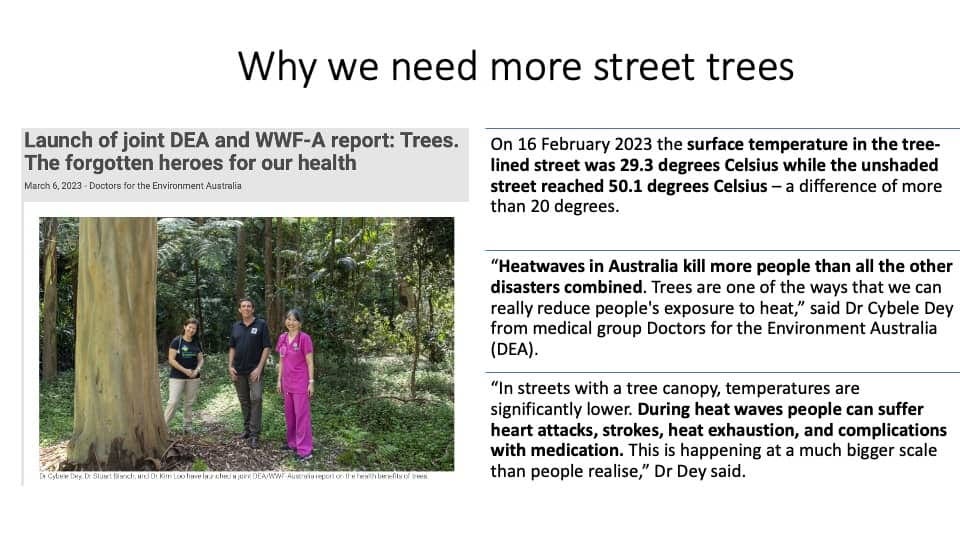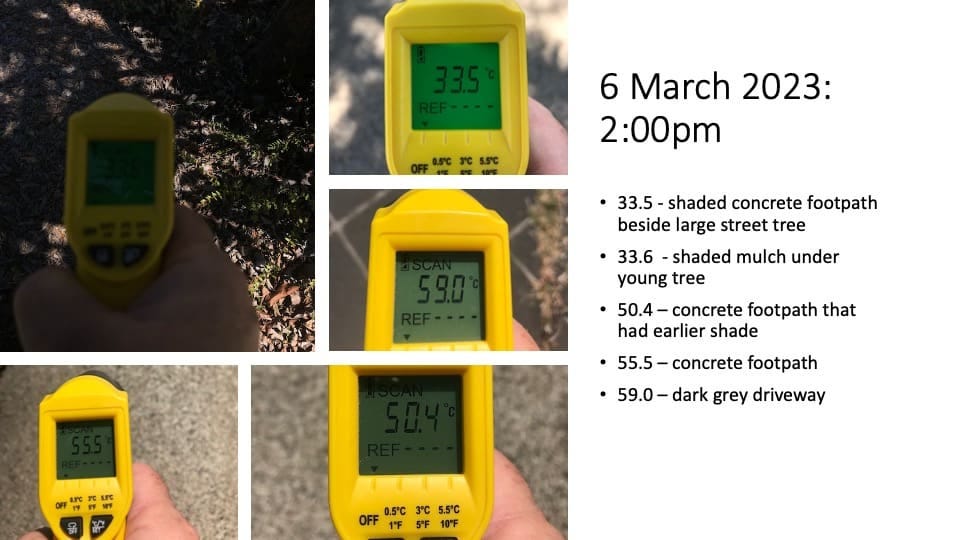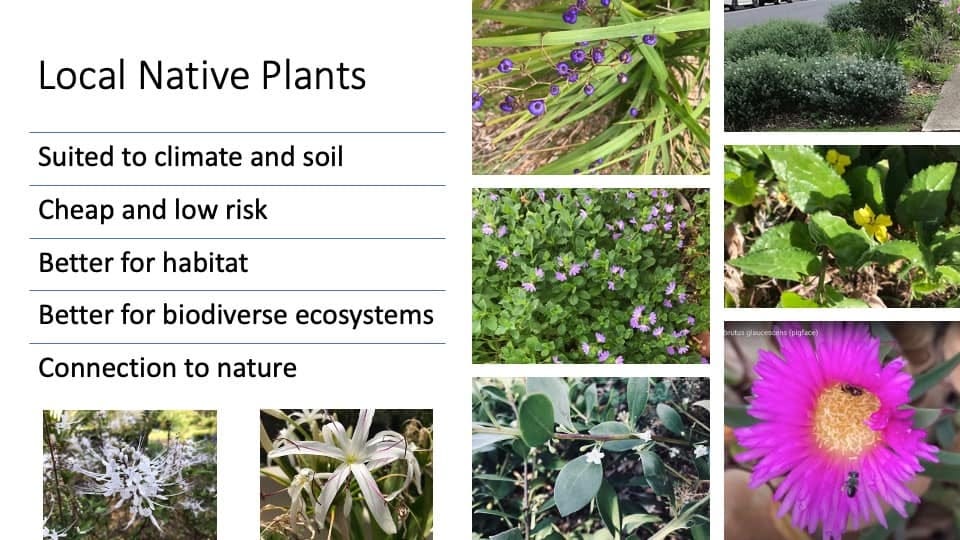Why street trees and why native verge gardens
This is based on a presentation for the Banyo Verge Garden Pilot Project in March 2023
This month, the World Wildlife Foundation and Doctors for the Environment launched a new report about the urgent need to address urban heat and the vital part that street trees play in cooling our suburbs.
See more at: https://dea.org.au/launch-of-joint-dea-and-wwf-a-report-trees-the-forgotten-heroes-for-our-health/
This isn't a new issue, but the urgency is growing.
In 2021, the Australian Conservation Foundation issued a report, Temperature check: Greening Australia’s warming cities, about the increasing heat that will make many of our suburbs unliveable. It's no longer people talking about numbers and dates in the future - it's happening here, and it's happening now.
Heat is not just coming from the sun above. The stored heat in all our hard surfaces increases what's known as the urban heat island effect. Some surfaces absorb and store more heat than others. That has led to initiatives like encouraging light-coloured roofs on our homes. In some cities, they are experimenting with painting roads with white paint but that raises issues with reflected heat and glare on pedestrians.
Shade and vegetation are the best ways of reducing urban heat. Green walls, green roofs and, most of all, street trees.
What a difference a tree makes
Last week, I measured the temperature on the footpath outside my home. This was 6 March - not mid-summer but still warm with day-time temperatures reaching high 20s and low 30s with high humidity.
The concrete path that had been in dappled shade all day was 33.5°C. Close to that was the mulch under my small street tree that would have received several hours of morning sun.
The concrete footpath was next: 50.4°C where it had been shaded for part of the morning and 55.5°C where it had soaked up heat from the sun all morning.
The dark grey driveway was 59°C - that's 25.5° higher than the shaded footpath.
I didn't measure the dark black road but I'm sure that would be even higher.
It's not just daytime heat
When I phoned the Banyo library to book the room for this presentation, on a similarly hot day, there was lots of noise in the background because so many people had come to get relief in their air-conditioned space.
It reminded me of past years when people would go to the shopping centres or cinema to escape the worst of the midday heat until it cooled off in the late afternoon and evening.
With the urban heat island effect, that heat is stored. It doesn't cool off as much in the evenings and it remains uncomfortably hot through the night.
Some of us can afford to retreat into our air-conditioned homes and commute in our air-conditioned cars to our air-conditioned workplaces. However, it still means we tend to be more socially-isolated and less active. Both have physical and mental health implications.
For many more of us, 24/7 air-conditioned retreat is not an option. The direct effects of the heat on our bodies is added to isolation and inactivity.
Heat is particularly dangerous for the vulnerable: the young, the old, the ill, and those on many medications.
While we still need to reduce emissions from fossil fuels, we also need to find ways to mitigate the effects of the rising temperatures and urban heat islands. This is where our trees come in.
Street trees and gardens to support them
The environmental and health sectors have come together advocating for more trees for shade in our cities. Councils too have been trying to increase our tree canopy with more street trees on verges and other public land.
A native plant verge garden in keeping with the local council's verge garden policy will help new street trees survive and thrive. The garden designs out competition from grass and battering from mowing equipment for existing trees.
There is a common view, encouraged by the nursery industry, that native plants are less exciting. The slide below shows just some of the attractive native plants on my verge garden - see a list here. There is always something in flower.
just some of our local native plants to add colour, interest, and biodiversity
Local native plants have many advantages over other planting for verges, including:
They are suited to the soil and climate so are more likely to survive with only a little water required while they become established. No herbicides or pesticides required.
Tubestock are cheap and there is less pain if some are lost through damage, vandalism, theft, etc
They are best for habitat - local flora for local fauna
A mix helps nurture a biodiverse ecosystem with plants flowering at different times of the year.
They encourage gardeners and passers-by to get to know our local plants as they connect with nature as part of daily life.
Many are only available from community nurseries and native plant groups.
Streets are for everyone
Street trees must be the highest priority for shade and cooling the streets.
Just imagine if councils and residents worked together to make it happen.
Councils planting street trees with residents providing the water and native verge gardens to increase biodiversity and help the trees thrive.
In every street, every suburb, every city.
The trees we need in 2030 need to be planted now. Let's get planting.
Our free course, Verge Garden Basics - Understanding the Space is about understanding the complexities of gardening on our streetsand an introduction to planting as advocacy and building connections.




